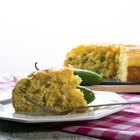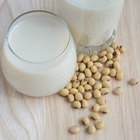ALLEKO/iStock/GettyImages
Baking is a science. Whether you’re trying to create a more tender crumb, improve browning or alter the color, it all comes down to adding the right ingredients in the right amounts. Cream of tartar is such an ingredient. In scones, it works to activate the baking soda and help it develop a more airy and tender treat.
What Is Cream of Tartar?
Cream of tartar, a white powder most often found in the spice section of your grocery store, is an acidic byproduct created from the making of wine and grape juice. It's most often used to add stability and stiffness to egg whites. In baked goods, in addition to activating the baking soda, it also works to create a whiter product. Flavones, which are pigments in batter, remain clear in the acidic environment created by the addition of cream of tartar, allowing the final baked good to remain whiter. An example might be an angel food cake made with cream of tartar versus a typical baked cake, which is more yellow in color.
How It Helps Scones
Not all scone recipes call for the use of cream of tartar, which may make you wonder why you would need it. If you’re using baking soda as the leavening agent for your scones without adding an acidic agent, your scones may come out dense and tough. The cream of tartar works to help the baking soda create the carbon dioxide that adds the lift in the scone batter for a more porous end product, which means a lighter and more tender scone. It also creates a scone that is whiter in color from the effects the acid has on the pigments in the batter.
If You Don’t Have Cream of Tartar
Depending on the type of cooking or baking you like to do, cream of tartar is one of those items you may or may not have in your cabinet. If the recipes calls for cream of tartar, most bakers would say there’s no good substitute. But in a pinch, you can substitute baking powder, which is a mix of baking soda and cream of tartar, in place of both in the recipe. One teaspoon of baking powder is equal to 1/4 teaspoon of baking soda and 1/2 teaspoon of cream of tartar. If a recipe calls for 1 teaspoon of cream of tartar and 1/2 teaspoon of baking soda, you would add 2 teaspoons of baking powder instead. But when altering a recipe, even when it looks like the substitution is an equivalent, you may end up with a slightly different scone. Lemon juice and white vinegar are also sometimes used as an alternative for cream of tartar, but more often when whipping egg whites. The liquid acids may not work as well in a scone recipe.
Related Articles

What Happens When I Put in Too Much ...

What Is a Substitute for Potassium ...

How to Make Sugar-Free Cookies With ...

What Can I Use as an Egg Substitute ...

Can You Make Scones With Coconut Flour?
Baking With Almond, Rice & Coconut Flour

What Can You Use in Place of Egg Yolk ...
What Can I Use As a Sugar Substitute ...

What Can Be Used Instead of Eggs for ...

Can I Make Boxed Devil's Food Cake Mix ...

How to Bake With Besan Flour

Can I Save a Cake if I Added Too Much ...

What Makes Food Coloring Darker When ...

Can You Use Konjac Flour in Baking?

The Purpose of Buttermilk in Baking

What Are the Ingredients in Elizabeth ...

What Is Food Coloring Paste?
What Is the Difference Between Cake ...

What Works With Baking Soda Besides ...

How to Substitute Soymilk for Buttermilk
References
Writer Bio
Jill Corleone is a registered dietitian and health coach who has been writing and sharing her love of food, nutrition and health with anyone who'll listen for almost 20 years. Her work has been featured on the Huffington Post, Diabetes Self-Management and Working Mother.